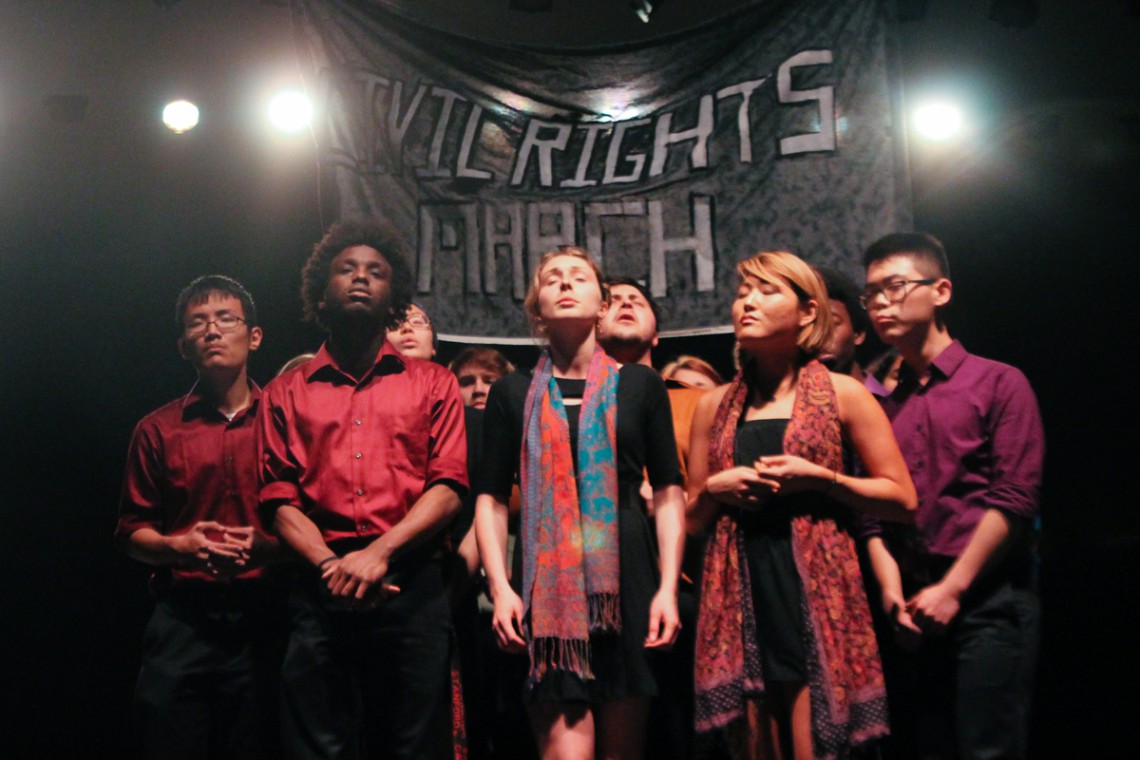Stanford student’s research contributes to the history of black sacred music
Students and members of the Bay Area gospel community perform Higher Ground, an original scholarly musical that explores the connection between black music and social justice. The production heralds the revival of Stanford's Committee on Black Performing Arts.
Jessica Anderson spent three months during her junior year immersed in the culture, sights and sounds of Cape Town, South Africa. Mostly the sounds. What she found in the music she heard around town was the influence of American swing, jazz and bebop, but also the African American gospel music of her childhood. She discovered through conversations with the Cape Town music community that gospel music helped lift the spirits of black South Africans throughout the apartheid struggle, as it did for African Americans during the civil rights era. She also learned that gospel music functioned as a form of protest music around the globe, including in the Czech Republic, India, Ireland, Norway and Zimbabwe.
What Anderson didn’t find in Cape Town or back in the States was much literature about black music, her music, and its rich and influential history. She reasoned that the lack of documentation could be partially attributed to the fact that this particular body of music and the people from which it originated customarily shared their history through the oral tradition. Additionally, history attests that these same marginalized communities have often been barred from publishing scholarly works, especially those that legitimize the cultural practices of such communities.
“I could not find my history in the literature, and it hurt,” she said.
Anderson decided to write the history of black sacred music in the form of a musical, Higher Ground: A Gospel Musical. “To know that the songs that I grew up singing have inspired generations of social movements around the world was ground-breaking news to me,” she said. “This project is an act of acceptance of my black Christian identity and a legitimization of this genre of music.”
The Higher Ground cast features 14 Stanford students and Bay Area professional performers plus Stanford Talisman and the Bibleway Voices choir from San Jose. The musical is being presented at Dinkelspiel Auditorium one night only on Saturday, March 1, at 7 p.m. It is free and open to the public. Seating is first-come, first-served.
Moments as movements
Higher Ground unfolds in five movements that represent significant moments in black sacred music history. Anderson employs live music, dance, spoken word, nonverbal drama and visual projections to tell the story of the music taking root in 19th-century antebellum American spirituals and sprouting into the gospel genre with global influence by the mid-20th century.
The story explores how the music cemented and characterized communities such as the black Pentecostal church and how it galvanized social justice activism during the civil rights era in America.
The movements cover nearly 175 years of music history and focus on moments in rural Mississippi, Los Angeles, Detroit, Tulsa and around the globe.
Anderson points out that existing research of black sacred music concentrates on the golden age of gospel music following World War II, as sung by Mahalia Jackson and a very young Aretha Franklin, and the early spirituals of American slavery.
Higher Ground expands the limited body of literature by highlighting sounds that emerged in typically unacknowledged periods of black sacred music history, including the Azusa Street Revival in Los Angeles in the early 1900s and the rise of international influence during and after the 1960s. “In addition to unearthing buried sounds in the history of black sacred music, Higher Ground breaks historical ground by being both a scholarly and artistic work,” Anderson said.
After the live performance, Higher Ground will live on in text format as Anderson’s honors thesis, accessible through the Program in African and African American Studies. A video of the performance will be available later this spring.
Supporting black arts
One of the many co-sponsors of Higher Ground is Stanford’s Committee on Black Performing Arts (CBPA). Founded in 1968, CBPA has been dedicated to exploring the narratives, histories and identities of the African and African American diaspora through arts. It has been relatively quiet in the recent past, but new student leadership is about to give the organization a louder voice on campus.
“As an institution, CBPA fostered a cultivation and appreciation for the arts rooted in the black experience, and engaged students in continuing its creation. Additionally, the organization challenged students and artists to utilize their talents to engage in scholarship, activism and community building,” say the new core leaders, Kalyn McCall, Olivia Smarr and Elliot Williams. “Our purpose is what it has always been: to create spaces and conditions that foster the creation and appreciation of black art and that foster the growth and interdisciplinary collaboration of black artists.”
In addition to co-sponsoring Higher Ground, CBPA will host a “talkback” in Dinkelspiel after the performance.
“As someone who plans to pursue performing arts as a career, Higher Ground is the perfect launching pad,” Anderson said of her writing, directing and producing experience on this project. “I have performed for the last 10 years and curated performances for the last five, but this is my first opportunity to direct and produce such a large-scale original work. The hope is that I will be able to take this production off campus and eventually expand it over the next few years.”
“Over the past four years, Jessica and her peers have enlarged and inspired the student arts community in powerful ways,” said Jeff Chang, executive director of the Institute for Diversity in the Arts. “CBPA’s timely return is the direct result of an extraordinary group of students coming together to envision and enact a renaissance of black student arts at Stanford.”


